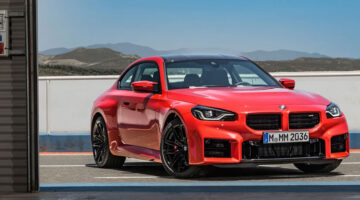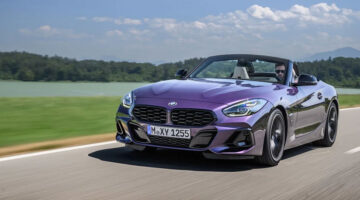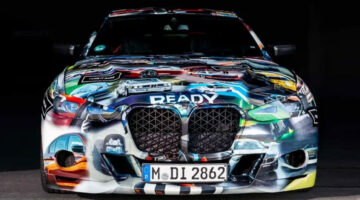We sit down with Adrian van Hooydonk, the man in charge of design across the BMW Group, and talk about the past, the present and the future, about the new i8 and i3 and about how the future of MINI is luxury.
[Not a valid template]When you look back at the history of BMW, which are the iconic designs that really stand the test of time?
That’s a good question. There are many. I go to the BMW Museum often and sometimes even get a chance to drive the old cars. I drove the 328, a car over 75 years old, in the Mille Miglia. That car was really built out of aluminium, is lightweight, has a six-cylinder inline engine, and in terms of design has very big wheels, a long bonnet. It’s really influenced our design language even until today.
Then there’s the 507 and the 503, which is very elegant and luxurious. The 3.0 CSL is a car that I like a lot, and also smaller cars like the 2002 because it set BMW on a track after the war to make small premium cars that would go fast. And we still do those kind of cars.
Then you have cars like the Z8 and the M1 have become icons, and you can see that by the values of our cars, which keep rising. I own a couple of classic BMW motorcycles too. I love the history of our products and I’m very proud to be able to design for such a strong brand.
When you design a new car, are you designing it for now, or with posterity in mind?
Typically we are always thinking ahead. It takes roughly three years to develop a design and our cars are in the market more or less unchanged for eight years. That means that at the beginning of a design phase we are thinking ahead some 12 years, which is hard to do to be honest. It’s hard to predict exactly what will happen in the world around us 12 years from now or how that will influence what people will want to buy.
When you get a chance to design a whole new brand like BMW i, with technology that is really new, we felt from the beginning that it would represent a new dawn. Not every car company is taking this approach. Everybody knows in some way or form that this new type of mobility is coming, nobody can avoid it. But different car companies are dealing with it in different ways. Some are trying to put new technology into an existing design and see how that goes, but we have taken a more radical approach. We felt if we do that, we can explain better what is so new and what is so interesting. We wanted to create products that people fall in love with so that they will take this new technology on board faster than they would otherwise have done.
How did the design of the i8 and i3 evolve?
Four years ago in Frankfurt we showed a concept called Vision Efficient Dynamics. At that point we had already started the design of the i3 but were in the early stages. The Vision Efficient Dynamics was a concept car whose job was to show that this new type of mobility can be fun and highly emotional. I think we achieved that; the reactions we got were very positive. So from that we got more inspiration, and the design of that concept car influenced both the final design of the i3 and led to the i8. From that moment on, things accelerated.
Proportionally the two cars couldn’t be more different. One is designed to drive in the city, the other is designed to drive out and then go as fast as you like. But they have a couple of things in common. The design language is equally modern, very clean. The sports car is done in a way that communicates the fact that is a sports car without the traditional cues – no air intakes, no movable spoilers, no wide tyres, no four exhausts – and yet I think everyone will take it seriously as a sports car. It’s quite revolutionary in its field.
This cleanliness is also visible in the i3, and also some aerodynamic features that you can see on the i8 too. They are an integral part of the design language right from the beginning. The design also expresses the fact that these cars are light, made of carbon fibre, which you can see when you open the doors around the sill area. We express that by making some of the panels float. The roof rail also seems to flat, and the dashboard elements too. That communicates the lightness.
How does new technology affect you as a designer, and what do you think will be the next technology to really make an impact in terms of design?
One examples is LED as a light source, which is incredibly small, and what that allows us to do is sort of paint with light. The tail lamps, for example, you don’t know where the light comes from. We have a very recognisable signature now for all our cars, and the i8 has that at another level, and LEDs make that possible. Inside, we can make light come out of the smallest slots so we use it as ambient lighting to create a very nice atmosphere and also highlight key design lines.
The next technology that I think will be very relevant for us in design is internet connectivity, the digital revolution that is going to happen. Already now we offer head-up displays, very large displays, touch commands and I believe that the next steps will be in the way of user interface as we have seen in the world of cell phones and computers. The interface changed more than the actual design, and I think with cars we’re beginning that revolution now.
Carbonfibre allowed us to make the i3’s new door system that allows very good access, even in a compact vehicle. That’s only possible because it’s so light and stiff. Carbonfibre or injection-moulded plastic are materials in which you can do very complex shapes, as you also can see in the i8. We did get a lot of design freedom from these new materials.
MINI is a brand firmly rooted in heritage. Does that restrict you in terms of design for the future?
I always see history and DNA as an advantage. In MINI of course you have to know the brand. It started as just one car and that car did not change for 45 years. That means that with MINI we are in a different part of its life compared to BMW, a brand almost 100 years old that has had new product added almost every year.
With MINI it’s been around 10 years since we took it over, and since then I think we’ve managed to revive it quite well. It is now a global brand with seven products in its range and I think it appeals to people that know the old car as well as the people that didn’t. That was the key objective. In the next 10 years I can see us doing design that is more modern than what we’ve done so far. MINIs will become more luxurious, we will improve the ergonomics and add modern technology like head-up displays and internet connection. I see a good future for MINI because as the i3 proves luxury can also come in a smaller form.
What cars inspired you to the point where you are today?
I’ve only worked on BMWs for the past 21 years, but from other brands there are quite unique cars like the Citroen DS and XM, or the Lancia Stratos Zero concept car or an Alfa 33 Stradale. Those are cars from Franco Scaglione that made an impression on me when I was getting involved in car design.
As a designer I couldn’t be more happy than working with the brands that I have because each caters to people that love driving. It’s always about the driving sensation and the design that we do already communicates that. They all have different characters and experiences.



